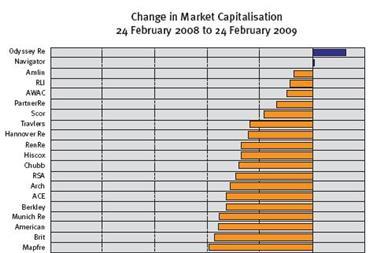In his only UK interview, Moody's whistleblower Eric Kolchinsky offers a glimpse into the inner workings of the rating agencies and warns Nathan Skinner that systemic problems are getting worse not better
As the financial crisis unfolded, investors, regulators and journalists all took turns criticising major credit-rating agencies for issuing inaccurate ratings. The agencies’ overly optimistic ratings on complex financial instruments encouraged investors to funnel billions into dodgy, sometimes worthless, securities. And this is believed to have been a major contributing factor in the credit crisis.
But despite regulatory reviews and lawsuits on both sides of the Atlantic, Eric Kolchinsky, a former senior analyst at Moody’s Investor Services, says that the rating agencies are still issuing inflated ratings and, far more improving, the problems have actually got worse. Kolchinsky claims that he was booted out of Moody’s due to raising his concerns internally and with his supervisors.
“We have not cured the disease,” he says. “In many ways, the incentives for rating agencies have become worse since the credit crisis. There are now more rating agencies and they are all chasing significantly fewer transaction dollars.”
Kolchinsky has taken his views to a congressional inquiry in the US. Now, in his first interview with a British journalist since the hearing, he tells StrategicRISK what life was like inside Moody’s, the structural problems that led analysts to issue overly rosy outlooks on subprime-backed securities and what urgently needs to be done to improve standards.
Throughout most of 2007, Kolchinsky was the managing director in charge of the unit that rated asset-backed collateralised debt obligations (or ABS CDOs). Based on his experience, he believes these subprime-backed instruments are “toxic” and should be binned for good. The rating agencies, however, continue to rate them.
Back in 2007, Kolchinsky was worried that Moody’s was issuing high ratings on securities backed by poor assets. In 2009, he wrote a letter to his bosses warning that analysts were issuing inaccurate ratings. He also raised the issue with the US Securities and Exchange Commission (SEC). But he steers clear of blaming the supervisor. “The regulators have got enough on their plate,” he says. “It [securities] is not an easy area to regulate.”
In September, Kolchinsky was suspended. Moody’s insists Kolchinsky was suspended with full pay because he refused to co-operate with the independent investigation that was charged with exploring his allegations. Kolchinsky believes he was given the shove because he refused to rate those iffy CDO deals.
Guilt
Kolchinsky still feels partly responsible for the financial problems and it was this sense of guilt that contributed to his decision to blow the whistle. “I was in charge of rating CDOs and they didn’t work out well,” he says. “I tried to do the best I could but obviously I failed miserably. I think it is important to learn the lessons from your mistakes.”
Within days of being dismissed Kolchinsky, agreed to present his evidence to the US House Committee on Oversight and Government Reform, which was investigating the role and influence of rating agencies. He was also interviewed live on CNBC and Bloomberg.
At the same time, a colleague of Kolchinsky’s, Scott McCelskey, formerly head of compliance at Moody’s, came forward to voice to the body of evidence against Moody’s.
McCleskey presented a letter to the congressional hearing that he’d originally sent to the SEC in March. In it he urged the securities supervisor to review the rating system, and in particular surveillance of public finance – in other words, the debt issued by states, counties, municipalities and school districts.
“While serving as head of compliance, I became aware that, at the time, virtually no surveillance was being performed on US public finance ratings,” the letter read. “My guidance was, to put it politely, ignored.” In fact, McCleskey, revealed that he’d been specifically told by the legal department not to mention the issue in any written form.
In his evidence to the House, McCleskey warned of the possibility of another wave of defaults on highly rated securities causing wide-ranging systemic effects on an already weakened financial system. “Investors may think they are holding investment-grade bonds when in fact the issuer is teetering on the edge of bankruptcy,” he explained.
The problem then and still, according to Kolchinsky, is structural. “The system does not incentivise the rating agencies to say ‘no’. No one asked us to lower our standards; in fact, if you managed to raise standards and still maintain your market share, everyone would be much happier. But at the end of the day, you could never say ‘no’ to a deal.”
Moody’s refutes this allegation, claiming that it often declines ratings but, when asked, it failed information on the number of ABS CDOs it had refused to rate during 2007.
It is an inability to overcome this fundamental conflict of interest – no transaction to rate, no fee – that, many believe, has led to problems throughout the financial system. “Today, there is even less of an incentive to say ‘no’ because there is less money around and there are even more rating agencies,” Kolchinsky says.
Poor incentives exist all the way through the securitisation chain, Kolchinsky claims. Lots of parties receive their fee based on the successful completion of the transaction, which means there is no incentive, other than a moral duty, to ensure the product has a long shelf life beyond that point.
Furthermore, financial firms were too ready and willing to believe everything their models told them. “Models can be twisted to say what you want them to say,” Kolchinsky explains.
Risky
When asked what it was like working for the unit in Moody’s that rated subprime securities, Kolchinsky says: “It was crazy. There were a lot of those deals going on. And people knew they were risky.”
“We were definitely understaffed,” he adds. Other senior managers also complained that the size of the ratings teams were insufficient to perform all the ratings – which exceeds 137,000 across Moody’s business.
Within the rating agencies, the balance of power is stacked heavily in favour of the business managers, Kolchinsky claims. During his tenure with Moody’s, he claims analysts were routinely bullied by business line managers and their decisions were overridden in the name of generating revenue. “It is sort of analogous to financial institutions, where the bankers are leaning on the risk managers to sign off on deals,” he explains.
According to Kolchinsky’s evidence, Moody’s compliance department was understaffed and had little professional compliance experience. “Instead of ensuring that the ratings process is free from conflict, the group sits idly by as these transgressions occur,” he says.
“I still think Moody’s is a good company, mostly, and mostly they are good people. Ninety-five percent of the people are trying to do the right thing. But you need to be able to control business managers, just like in any company, and for that you need an independent compliance department, especially at a rating agency,” he says.
A spokesperson for Moody’s responds [check]: “We have very strong policies and procedures in place to manage conflicts of interest. We acknowledge that there is a potential for conflict of interest in any business; the key is how well we manage that conflict. We have a long history of managing that conflict and we have a number of safeguards in place.”
He adds: “Our ratings aren’t assigned by an individual analyst, they are assigned by a committee of analysts who each have a vote in the committee. In addition, compensation for Moody’s analysts and senior managers is not linked to the financial performance of their business unit. Fundamentally, we do not take commercial considerations into account when we develop methodologies or assign our ratings.”
Broadly speaking, Kolchinsky criticises the methodologies that rating agencies use for rating structured finance securities. He says they are “unrealistic” and “haphazard” and they are never validated if that means jeopardising revenues. In his opinion, the ratings are not revisited regularly enough to ensure accuracy and to realistically reflect the underlying credits. Markets can change very quickly, but, according to Kolchinsky and others, certain ratings stand for years without ever being reassessed.
To this assertion, Moody’s responds: “We are fully transparent about the basis for our ratings. Our methodologies are freely available on our website. It would be clear to the market if we did not adhere to our methodologies, they are in the public domain.”
Long way to go
The most worrying of the allegations against the agencies is that none of these structural problems have actually improved since they spectacularly failed to help avert the financial crisis. The poor incentives, conflicts of interest and poor methodologies all persist, Kolchinsky says, and this is storing up problems for the future. “The problem with the market today is there’s a feeling that we’ve passed the hump. In my view, we’ve stabilised the patient but we’re only treating the symptoms. We’ve still not addressed the core fundamental problems that exist; we’ve not cured the disease.”
Several treatments have been suggested. These range from overhauling the model so that buyers – in other words, the investors – pay for ratings, to replacing the rating agencies with a regulator. The problem with that is regulators don’t want to step in and tinker with the system too much during such a tumultuous period. There are also suggestions that credit insurers could take over the mantle and determine a company’s credit worthiness.
The only effective proposal, New York Insurance superintendent Eric Dinallo says, is a system of self-funded buy-side ratings that are paid for by the investors that use them. But this model isn’t free from conflicts of interest either, Kolchinsky says. In his experience, most asset-backed CDOs are retained on the balance sheets of the banks themselves. “For most of the executions in my product area, the issuer and the investor were the same party,” he says. “It was practically an ‘investor pays’ model.”
One thing that would help is better regulation, he says. “You have to begin by accepting that rating agencies perform a quasi-regulatory function. If someone is performing a regulatory role, you cannot have them competing completely unfettered.”
“When there was no competition among rating agencies and it was just Standard & Poor’s and Moody’s, then they were known to be aloof and if they said no that meant no and the deal would not go through. Once they started competing with each other, there was a race to the bottom.”
“Fortunately, a model already exists that combines quasi-regulatory authority with private competition – it is the accounting industry,” Kolchinsky says. He believes the accounting profession, while not free from conflicts of interest, has not suffered the same “freefall in standards that has befallen the ratings industry”.
The reason for this, he says, is that accountants adhere to a single set of global standards and methodologies, whereas each rating agency has its own methodology: Moody’s rates to expected loss, whereas Fitch and S&P rate to the probability of default. Each institution also defines “Triple A” differently. The minute details of each of these particular methodologies make it hard for regulators or investors to understand the ratings they are getting.
Standards exist for the ratings industry, but they are voluntary and consequently not applied all that frequently. Only seven out of 21 credit ratings agencies surveyed by the International Organisation of Securities Commissions had actually incorporated the Credit Rating Agency Code – which is intended as a standard of good practice.
Changes are afoot and, as a result of the financial crisis, the ratings industry appears to be on the brink of a much more stringent regulatory regime, which could try to enforce standards. The US House Financial Services Committee recently agreed to set new rules for the rating agencies. The bill, which still faces scrutiny from the Senate, would allow the SEC to test the methods employed by ratings agencies and to sanction lax supervisors. In March, European states [check – EU member states?] also agreed a deal to introduce mandatory registration and supervision of the agencies.
Ultimately, investors will have a responsibility to conduct more due diligence themselves and not simply rely on a credit rating to tell them everything. In the future, much less importance is likely to be attached to the credit rating. These developments could signal the end of their reign as the dolers of judgment in the financial system.
“If I were a doctor,” Kolchinsky says. “I would diagnose the rating agency patient as very curable. But treatment needs to be urgently applied to avoid further damage.”



















